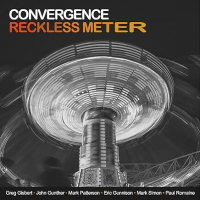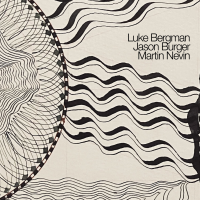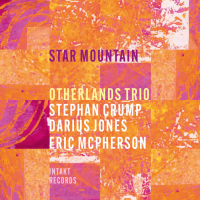Home » Jazz Articles » Album Review » Curtis Counce: Curtis Counce/Jack Sheldon/Harold Land/Ca...
Curtis Counce: Curtis Counce/Jack Sheldon/Harold Land/Carl Perkins/Frank Butler Quintet: Complete Studio Recordings
An accompanying booklet offers a retrospective by the leader following the death of the group's brilliant 29-year-old pianist Carl Perkins and the subsequent disbanding of the group: "In spite of the accent on the individual—or possibly because of it—we worked together so well that on some nights we felt and sounded like one person." The delicate balance so essential to the integral effect of the ensemble is apparent on the few instances when a single member is replaced—for example, Elmo Hope for Perkins or trumpeter Gerald Wilson for Jack Sheldon. The contribution of each of the five principals, therefore, invites close scrutiny:
Tenor saxophonist Harold Land, who was on most (and the best) of the Clifford Brown-Max Roach Quintet recordings, is heard to even better advantage here. Land was a small-toned, hard-edged, no-frills player whose every solo was at once a model of efficiency and flawless execution. In 1958 pianist Victor Feldman told critic Nat Hentoff that Harold Land was "the best tenor on any coast"—a debatable but defensible statement. Few improvisers played with a cannier sense of logic—it's as if he sees his destination as well as the whole playing field before each solo, then navigates his course with forward-leaning lines that reach their target with an absolute minimum of waste or predictability. If John Coltrane had a skyward vision, Land's was panoramic. His solo during his own "Landslide" is the musical equivalent of a swift and graceful Catalina opportunistically tacking its course with resourceful expertise and purpose.
Apart from the logic of his constructions, Land's most expressive tool is his phrasing. He begins by scaling down a melody's proportions to the size of his sound, then shapes and contours his own lines through careful attention to dynamics. His melodic phrases "breathe," or expand and contract, not only making him an effective ballad interpreter (his exquisite reading of "Time After Time" rarely departs from Jule Styne's original melody) but an invaluable ensemble member, whether complementing a Clifford Brown or Jack Sheldon. Besides doubling the sound of the other player, he contributes to the glowing and vibrant quality of the ensemble choruses. Few players, moreover, are so aggressively focused coming out of the chute—that unnerving break between the ensemble head and the soloist's first chorus. Land begins creating while suspended in mid-air, then hits the ground running, virtually erasing the distinction between ensemble and solo sections.
Pianist Carl Perkins was one of the most distinctive voices to emerge on the instrument in the 1950s, combining Bud Powell's urgent melodic lines with Erroll Garner's rhapsodic orchestrations into a highly personal style. As a pianist, I can attest that his chord voicings and comping defy transcription, not just the notes but the touch and placement of them opening up the spacious sound of the ensemble (bassist Leroy Vinnegar, who grew up with Perkins in Indianapolis, says of his childhood friend, "He not only played the chords—he played the beauty in the chords, and his time was perfect").
Beginning with the opening track, "Landslide," each Perkins solo is a rapturous quest, the beauty of his singing executions magnified when the listener considers the physical handicap he faced. Playing with a left hand deformed by polio, he can be seen in photos holding his arm not at a right angle to the keyboard but parallel with it, his thumb often pointing toward the bass notes being "fingered" by his elbow. Counce insisted that the truly unique sound of the group owed more to Perkins than anyone else. It's small wonder the unit broke up shortly after his death in 1958.
Trumpeter Jack Sheldon, the only surviving member, emerges on these recordings as a more bona fide West Coast challenger to Miles Davis than does Chet Baker.There were definite color lines as well as coastal divides in the jazz groups of the 1950s, and Counce wanted to counteract stereotypes of West Coast jazz as being removed not just geographically but creatively from its African-American East Coast counterpart. But in the case of Sheldon he simply had to make an exception. Land seems to have taken the multifaceted trumpeter under wing, helping shape his lines to ensure a tighter ensemble balance than that of the Brown-Roach quintet.
Although Sheldon's highly personal sound is as immediately identifiable as Land's, the pair's playing is of such a single voice that on the opening ensemble chorus of "Love Walked In," Sheldon's apparent flub of a crucial Eb sticks out as a rare mistake by an otherwise flawless group. But when, on each ensuing chorus, the trumpeter makes the same "mistake," we recognize it as an artfully finessed ornamentation, stamping the Gershwin tune as the group's exclusive property. Occasionally Sheldon's storied whimsy provides the Puckish moments that counterbalance the gravitas of the other players, especially when he skyrockets (albeit briefly and at much reduced volume) into the high registers favored by a Maynard Ferguson or Cat Anderson. But even these forays do no injury to the fluid structure of his own solos or the cohesion and balance of the group. The three tracks (out of 26) on which Gerald Wilson replaces Sheldon demonstrate the crucial importance of the latter to the integrity of the group.
Frank Butler was a drummer of prodigious skills, a pyrotechnician all too easily dismissible (especially by rival drummers) as a "showboat." His two feature numbers—"A Fifth For Frank" and "The Butler Did It"—will no doubt cause heads to shake as the soloist goes from sticks to brushes to knuckles to fingers and back without a tell-tale pause between each rearming and without missing a single clap of the hi-hat. Yet even these two "showpieces" reveal the musical values of his playing on all of the tracks—rarely calling attention to itself but always tasteful, empathetic, hard swinging, and mindful of the big picture. In fact, the sounds he extracts from his kit are so melodic that his solos, far from sounding like the usual, once-is-enough "clinic," invite as much replaying as the solo statements of the three principals. Above all, it's his unforced, flowing time that sustains the life of a musical assembly that is more organism than aggregation.
Curtis Counce, who died in 1963 of a heart attack, will be remembered primarily as an unselfish leader, a catalyst and enabler, his name inseparable from the music of the three main albums comprising this set. But he was in his own right a bassist whose contributions were every bit as vital as those of the other members. The architectonics of his infrequent solos reveal a greater indebtedness to the harmonic school of saxophonist Coleman Hawkins than the more linear one run by Hawkins' fellow hornman Lester Young. Compared to other bass players of his day, Counce is closer to Oscar Pettiford than to Charles Mingus, Ray Brown or Paul Chambers. On his solo feature, Ellington's "Sophisticated Lady," his inerrant pitch serves him especially well, and in his primary role as a "walker" his touch is light and buoyant, his tone rich and resonant, his note choices impeccable.
Finally, there's the beauty of the recorded sound—an approach to audio imaging practically opposite to Van Gelder's at Blue Note. Lester Koenig at Contemporary Records was known for extremely high audio standards and turned out some of the best-sounding records of the day thanks to the expertise of engineer Roy DuNann. Play the Counce version of "Nica's Dream" alongside the composer's (Horace-Scope, Blue Note, 1960). Van Gelder's Blue Note recording thunders with undeniable peak presence, a flat aural canvas on which each player is equally clear; by contrast, the audio on the Contemporary date is rich in depth and detailing, allowing the listener to pick out each of the subordinate motifs and subtle moving harmonies. Rather than plopping the musicians down into the listener's space, the engineering endeavors to create a naturally ambient soundscape inviting the listener's entrance.
The audio on this Spanish remaster contains some irregularities not on the original LPs— Sheldon's trumpet occasionally overshadows the tenor saxophone on unison lines, Perkins' piano accompaniment is at times too distant, the bass frequencies may be judged lacking by present-day standards—but on the whole the recorded sound of the originals has been faithfully rendered. It should be noted that the title— Complete—is somewhat misleading. The Counce group did, in fact, record another album minus Perkins and Sheldon for another label, and a fourth album of new masters by the original group was released on Contemporary in 1989 (Sonority). The producers of the present set have included three of the six previously unreleased masters from that collection, leaving unexplained the exclusion of the remaining three. Equally puzzling, two previously unreleased tracks on the second disc are truncated and obviously recorded by amateurs.
These caveats can hardly detract from the excellence of what remains: 24 tracks and over 150 minutes of music about which little more need be said than that it represents African-American indigenous art of the highest order. As mentioned earlier, this is a collection for the time capsule—or listeners who may not care to wait that long.
Track Listing
CD1: Landslide; Time After Time; Mia; Sarah; Fifth For Frank; Big Foot; Sonar; Stranger In Paradise; Woody'n You; Pink Lady; Councelation. CD2: Love Walked In; Too Close For Comfort; How Deep Is The Ocean; Complete; Nica's Dream; How Long Has This Been Going On; Mean To Me; I Can't Get Started; Larue; Carl's Blues; Night In Tunisia; Love Walked In; Sophisticated Lady; Fifth For Frank; The Butler Did It.
Personnel
Curtis Counce
bass, acousticJack Sheldon: trumpet; Harold Land: tenor saxophone; Carl Perkins: piano; Curtis Counce: bass; Frank Butler: drums. (Gerald Wilson, trumpet, replaces Jack Sheldon on three tracks of CD2.)
Album information
Title: Curtis Counce/Jack Sheldon/Harold Land/Carl Perkins/Frank Butler Quintet: Complete Studio Recordings | Year Released: 2007 | Record Label: Gambit Records
Tags
PREVIOUS / NEXT
Support All About Jazz
 All About Jazz has been a pillar of jazz since 1995, championing it as an art form and, more importantly, supporting the musicians who make it. Our enduring commitment has made "AAJ" one of the most culturally important websites of its kind, read by hundreds of thousands of fans, musicians and industry figures every month.
All About Jazz has been a pillar of jazz since 1995, championing it as an art form and, more importantly, supporting the musicians who make it. Our enduring commitment has made "AAJ" one of the most culturally important websites of its kind, read by hundreds of thousands of fans, musicians and industry figures every month.






















